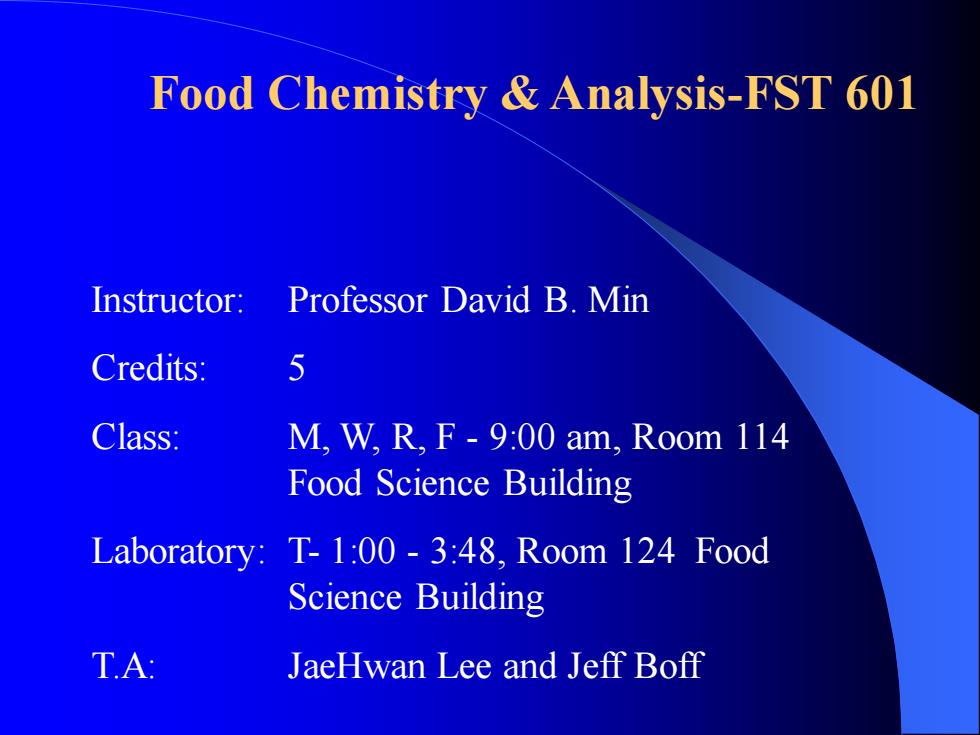
Instructor: Professor David B. Min Credits: 5 Class: M, W, R, F - 9:00 am, Room 114 Food Science Building Laboratory: T- 1:00 - 3:48, Room 124 Food Science Building T.A: JaeHwan Lee and Jeff Boff Food Chemistry & Analysis-FST 601
Instructor: Professor David B. Min Credits: 5 Class: M, W, R, F - 9:00 am, Room 114 Food Science Building Laboratory: T- 1:00 - 3:48, Room 124 Food Science Building T.A: JaeHwan Lee and Jeff Boff Food Chemistry & Analysis-FST 601
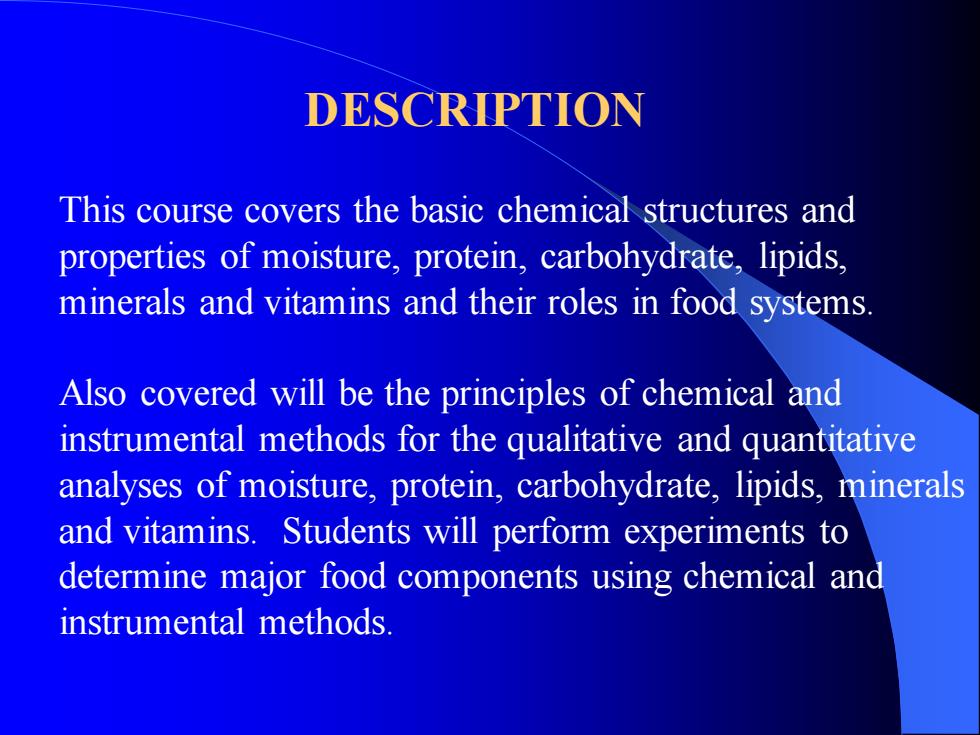
This course covers the basic chemical structures and properties of moisture, protein, carbohydrate, lipids, minerals and vitamins and their roles in food systems. Also covered will be the principles of chemical and instrumental methods for the qualitative and quantitative analyses of moisture, protein, carbohydrate, lipids, minerals and vitamins. Students will perform experiments to determine major food components using chemical and instrumental methods. DESCRIPTION
This course covers the basic chemical structures and properties of moisture, protein, carbohydrate, lipids, minerals and vitamins and their roles in food systems. Also covered will be the principles of chemical and instrumental methods for the qualitative and quantitative analyses of moisture, protein, carbohydrate, lipids, minerals and vitamins. Students will perform experiments to determine major food components using chemical and instrumental methods. DESCRIPTION
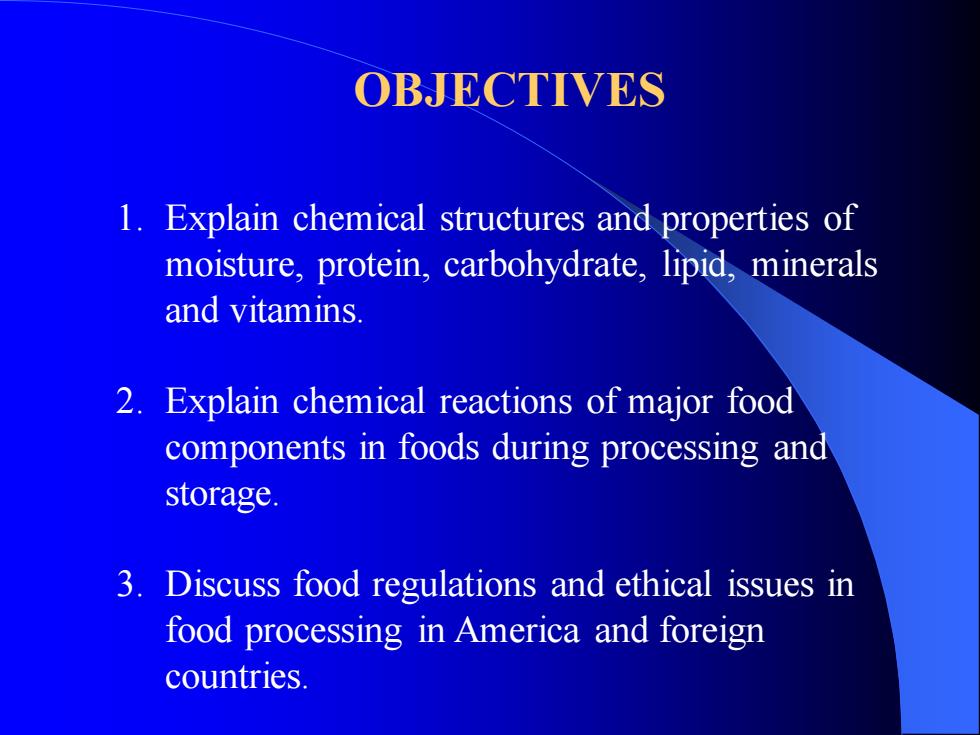
OBJECTIVES 1. Explain chemical structures and properties of moisture, protein, carbohydrate, lipid, minerals and vitamins. 2. Explain chemical reactions of major food components in foods during processing and storage. 3. Discuss food regulations and ethical issues in food processing in America and foreign countries
OBJECTIVES 1. Explain chemical structures and properties of moisture, protein, carbohydrate, lipid, minerals and vitamins. 2. Explain chemical reactions of major food components in foods during processing and storage. 3. Discuss food regulations and ethical issues in food processing in America and foreign countries
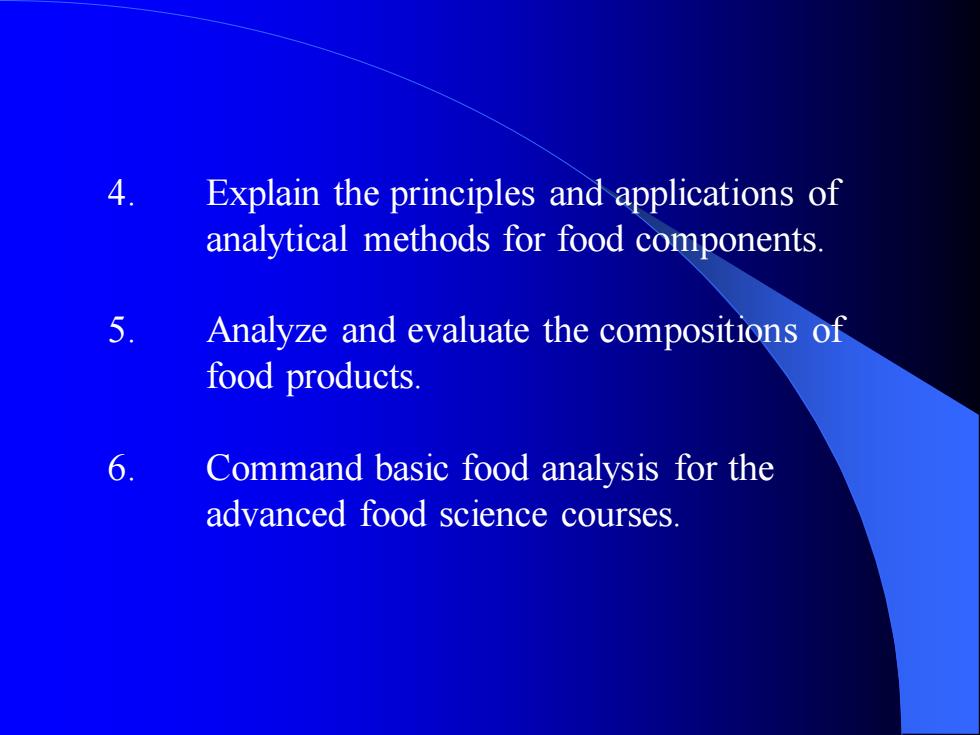
4. Explain the principles and applications of analytical methods for food components. 5. Analyze and evaluate the compositions of food products. 6. Command basic food analysis for the advanced food science courses
4. Explain the principles and applications of analytical methods for food components. 5. Analyze and evaluate the compositions of food products. 6. Command basic food analysis for the advanced food science courses

Midterm exam (4) 50% Final 20% Laboratory Report and Examination 20% Homework and Class Participation 10% GRADING
Midterm exam (4) 50% Final 20% Laboratory Report and Examination 20% Homework and Class Participation 10% GRADING
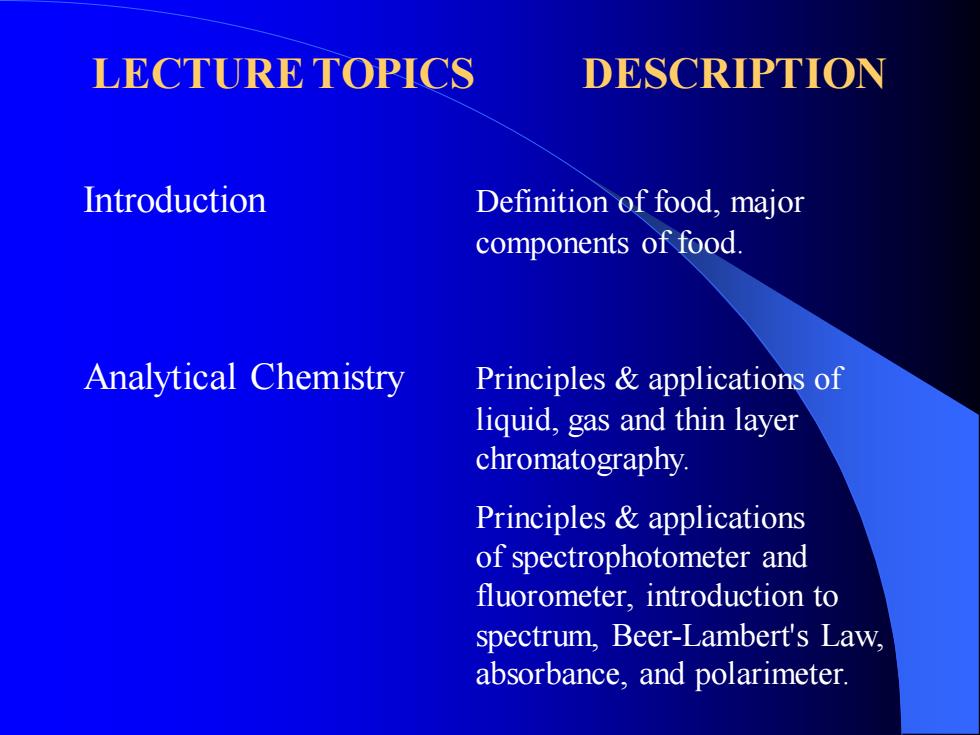
LECTURE TOPICS DESCRIPTION Introduction Definition of food, major components of food. Analytical Chemistry Principles & applications of liquid, gas and thin layer chromatography. Principles & applications of spectrophotometer and fluorometer, introduction to spectrum, Beer-Lambert's Law, absorbance, and polarimeter
LECTURE TOPICS DESCRIPTION Introduction Definition of food, major components of food. Analytical Chemistry Principles & applications of liquid, gas and thin layer chromatography. Principles & applications of spectrophotometer and fluorometer, introduction to spectrum, Beer-Lambert's Law, absorbance, and polarimeter
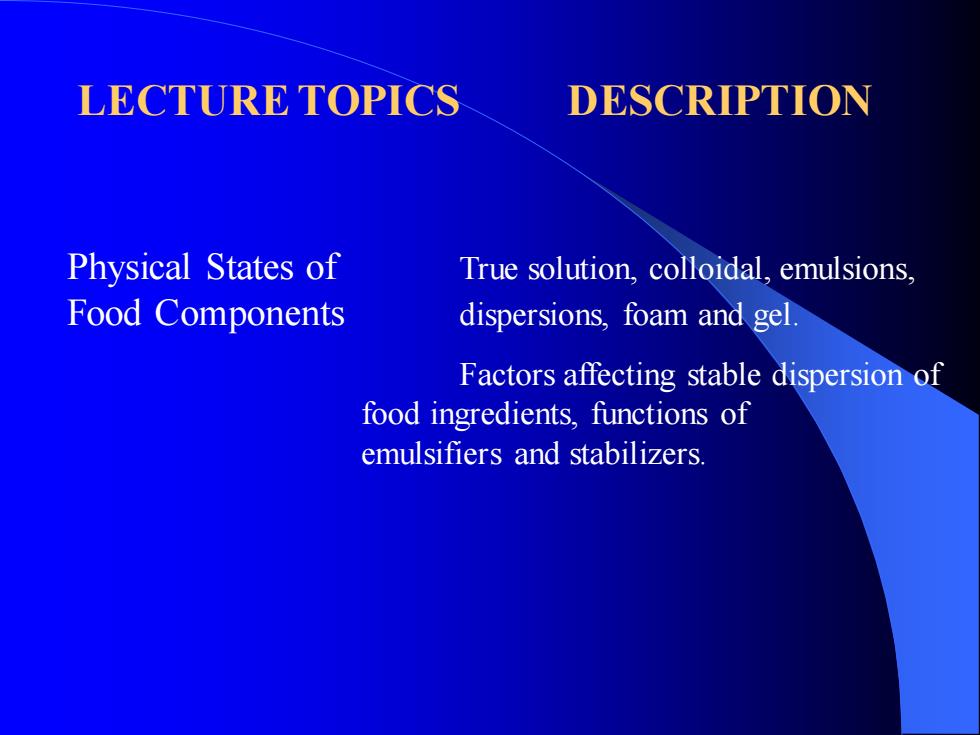
LECTURE TOPICS DESCRIPTION Physical States of True solution, colloidal, emulsions, Food Components dispersions, foam and gel. Factors affecting stable dispersion of food ingredients, functions of emulsifiers and stabilizers
LECTURE TOPICS DESCRIPTION Physical States of True solution, colloidal, emulsions, Food Components dispersions, foam and gel. Factors affecting stable dispersion of food ingredients, functions of emulsifiers and stabilizers
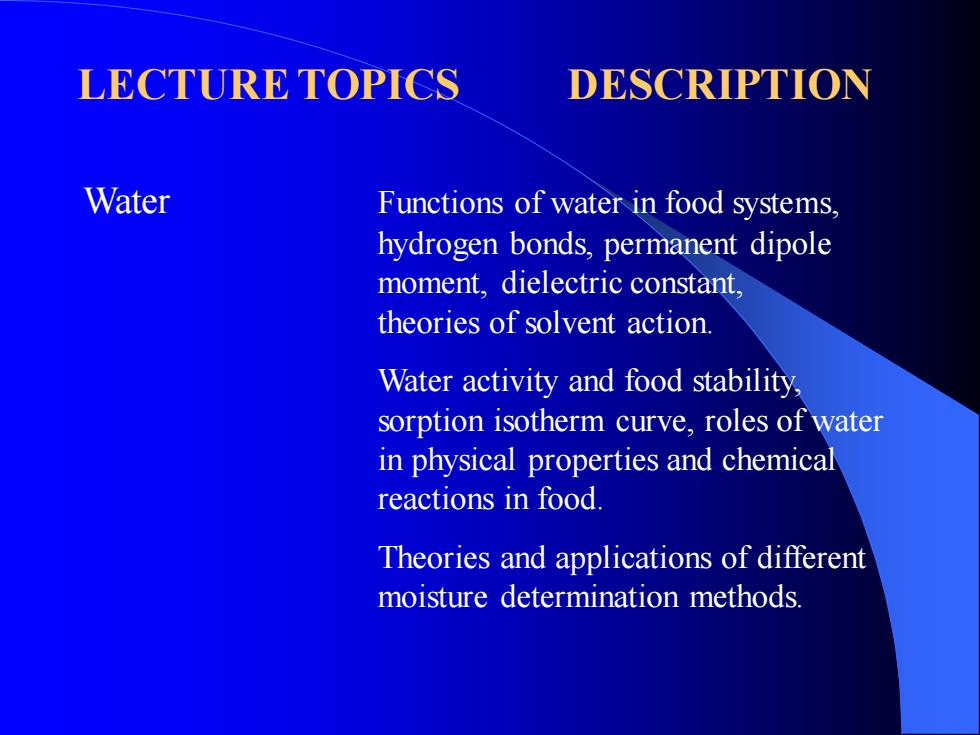
LECTURE TOPICS DESCRIPTION Water Functions of water in food systems, hydrogen bonds, permanent dipole moment, dielectric constant, theories of solvent action. Water activity and food stability, sorption isotherm curve, roles of water in physical properties and chemical reactions in food. Theories and applications of different moisture determination methods
LECTURE TOPICS DESCRIPTION Water Functions of water in food systems, hydrogen bonds, permanent dipole moment, dielectric constant, theories of solvent action. Water activity and food stability, sorption isotherm curve, roles of water in physical properties and chemical reactions in food. Theories and applications of different moisture determination methods

LECTURE TOPICS DESCRIPTION Protein Classification, nomenclature, and structures of amino acids, basic properties of protein, structure of proteins, protein functional groups and their chemical, hydrophobic, and hydrophobic properties. Isoelectric point and solubility as a function of pH, protein denaturation and its effects on food systems, nutritional quality of protein. Theories & applications of analytical methods for protein and amino acids determination
LECTURE TOPICS DESCRIPTION Protein Classification, nomenclature, and structures of amino acids, basic properties of protein, structure of proteins, protein functional groups and their chemical, hydrophobic, and hydrophobic properties. Isoelectric point and solubility as a function of pH, protein denaturation and its effects on food systems, nutritional quality of protein. Theories & applications of analytical methods for protein and amino acids determination
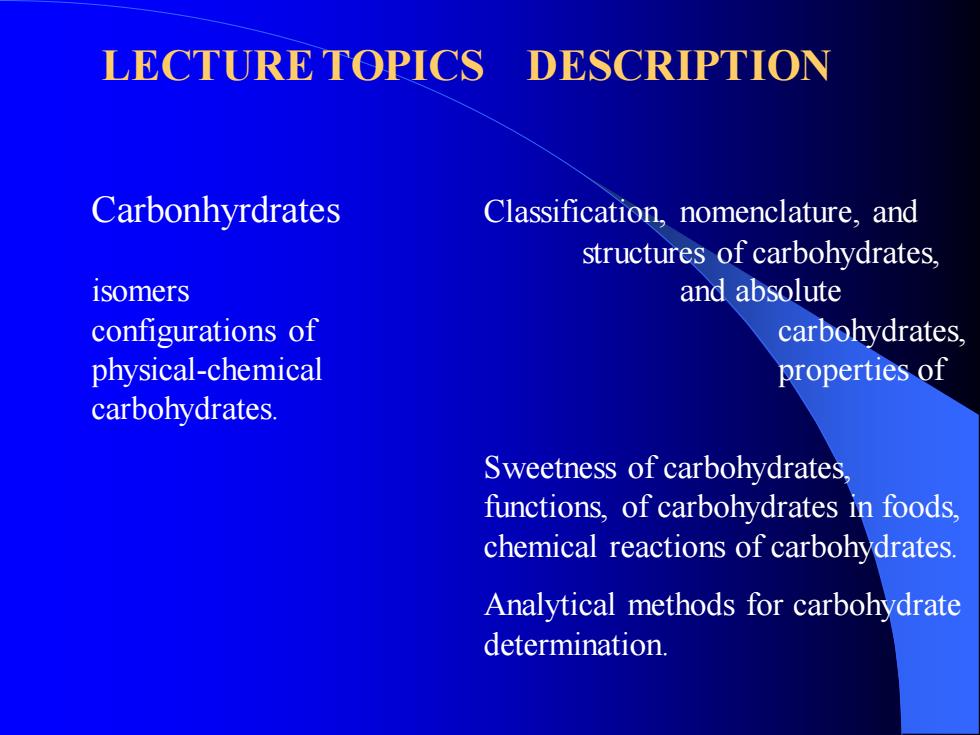
LECTURE TOPICS DESCRIPTION Carbonhyrdrates Classification, nomenclature, and structures of carbohydrates, isomers and absolute configurations of carbohydrates, physical-chemical properties of carbohydrates. Sweetness of carbohydrates, functions, of carbohydrates in foods, chemical reactions of carbohydrates. Analytical methods for carbohydrate determination
LECTURE TOPICS DESCRIPTION Carbonhyrdrates Classification, nomenclature, and structures of carbohydrates, isomers and absolute configurations of carbohydrates, physical-chemical properties of carbohydrates. Sweetness of carbohydrates, functions, of carbohydrates in foods, chemical reactions of carbohydrates. Analytical methods for carbohydrate determination